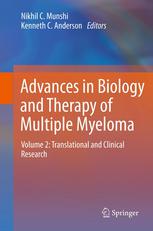مشاهده سبد خرید “Prevention and Early Treatment of Depression Through the Life Course 2022” به سبد خرید شما اضافه شد.
Advances in Biology and Therapy of Multiple Myeloma: Volume 2: Translational and Clinical Research 2012
دانلود کتاب پزشکی پیشرفتها در زیستشناسی و درمان مولتیپل میلوما: جلد 2: تحقیقات ترجمهای و بالینی
دسته: انکولوژی, پزشکی, عمومی, فارماکولوژی
ناشر:
Springer New York
| نویسنده |
Kenneth C. Anderson, Nikhil C. Munshi |
|---|
| تعداد صفحهها |
290 |
|---|---|
| نوع فایل |
|
| حجم |
2 Mb |
| سال انتشار |
2012 |
89,000 تومان
دانلود ۳۰.۰۰۰ کتاب پزشکی فقط با قیمت یک کتاب و ۹۹ هزار تومان !
توضیحات
با وجود پیشرفت در شیمی درمانی مرسوم، یک عامل جدید و با دوز بالا، مولتیپل میلوما (MM) غیر قابل درمان باقی مانده است. به منظور غلبه بر مقاومت به درمان های فعلی و بهبود نتایج بیمار، رویکردهای درمانی جدید مبتنی بر بیولوژیک در حال توسعه هستند. تحقیقات تحولآفرین کنونی در MM با تمرکز بر توسعه درمانهای ترکیبی مولکولی، نوید زیادی برای دستیابی به پاسخهای فرکانس بالا و بادوام در اکثر بیماران دارد. دو پیشرفت بزرگ این هدف را ممکن می سازد. اول، پیشرفتهای اخیر در ژنومیکس و پروتئومیکس MM به درک بیشتر از علت بیماری، شناسایی اهداف درمانی جدید، طبقهبندی مولکولی اجازه داده و یک منطق علمی برای ترکیب درمانهای هدفمند برای افزایش سمیت سلولهای تومور و از بین بردن مقاومت دارویی ارائه کرده است. . دوم، در حال حاضر درک رو به رشدی وجود دارد که چگونه چسبندگی سلول های MM در مغز استخوان (BM) بر بیان ژن در سلول های MM و همچنین در سلول های استرومایی BM (BMSCs) تأثیر می گذارد. در نتیجه این پیشرفت ها در ژنومیک از یک سو و افزایش درک نقش BM در پاتوژنز MM از سوی دیگر، یک مدل درمانی جدید با هدف قرار دادن سلول سرطانی و ریزمحیط BM آن برای غلبه بر مقاومت دارویی و بهبود بیمار. نتیجه در حال حاضر توسعه یافته است. تالیدومید، لنالیدومید و بورتزومیب سه عاملی هستند که سلول سرطانی را در ریزمحیط آن در مدلهای آزمایشگاهی و حیوانی مورد هدف قرار میدهند و به سرعت از نیمکت به بالین ترجمه شدهاند. تلاشهای در حال انجام با استفاده از مطالعات ژنومیک و سیگنالدهی سلولی برای شناسایی نسل بعدی درمانها در MM از یک سو، و اطلاعرسانی به طراحی آزمایشهای ترکیبی از سوی دیگر است. این مدل جدید برای غلبه بر مقاومت دارویی و بهبود نتیجه بیمار در MM نه تنها برای تغییر تاریخ طبیعی MM، بلکه برای خدمت به عنوان مدلی برای درمان های هدفمند برای بهبود نتیجه بیماران مبتلا به MM نویدبخش است.
توضیحات(انگلیسی)
Despite the advances in conventional, novel agent and high dose chemotherapy multiple myeloma (MM) remains incurable. In order to overcome resistance to current therapies and improve patient outcome, novel biologically-based treatment approaches are being developed. Current translational research in MM focusing on the development of molecularly-based combination therapies has great promise to achieve high frequency and durable responses in the majority of patients. Two major advances are making this goal possible. First, recent advances in genomics and proteomics in MM have allowed for increased understanding of disease pathogenesis, identified novel therapeutic targets, allowed for molecular classification, and provided the scientific rationale for combining targeted therapies to increase tumor cell cytotoxicity and abrogate drug resistance. Second, there is now an increased understanding of how adhesion of MM cells in bone marrow (BM) further impacts gene expression in MM cells, as well as in BM stromal cells (BMSCs). As a result of these advances in oncogenomics on the one hand and increased understanding of the role of the BM in the pathogenesis of MM on the other, a new treatment paradigm targeting the tumor cell and its BM microenvironment to overcome drug resistance and improve patient outcome has now been developed. Thalidomide, lenalidomide, and Bortezomib are three agents which target the tumor cell in its microenvironment in both laboratory and animal models and which have rapidly translated from the bench to the bedside. Ongoing efforts are using oncogenomics and cell signaling studies to identify next generation of therapies in MM on the one hand, and to inform the design of combination trials on the other. This new paradigm for overcoming drug resistance and improving patient outcome in MM has great promise not only to change the natural history of MM, but also to serve as a model for targeted therapeutics directed to improve outcome of patients with MM.




